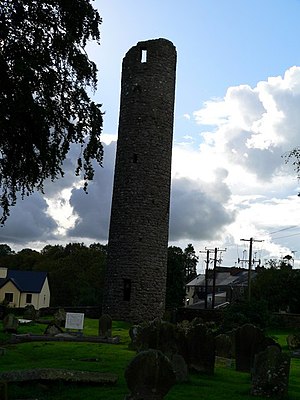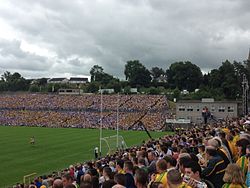Clones
| Clones Gaelic: Cluain Eois | |
| County Monaghan | |
|---|---|
 Clones town centre | |
| Location | |
| Grid reference: | H500257 |
| Location: | 54°10’59"N, 7°14’1"W |
| Data | |
| Population: | 2,500 (2006[1]) |
| Local Government | |
| Website: | http://www.clones.ie |
Clones is a small town and parish in western County Monaghan. The parish additionally extends into Fermanagh. The town was badly hit economically by the partition of Ireland in 1921 because of its location on the border with Fermanagh in Northern Ireland. The creation of the Irish border deprived it of access to a large part of its economic hinterland for many years. The town had a population of 2,889 (including the rural area) at the 2006 census.
Name
Historically Clones was also spelt Clonis, Clonish and Clownish.[2] These are anglicised versions of the Irish Cluain Eois, meaning "Eos's meadow". However, it is also said that the ancient name was Cluan Inis, "island of retreat," it having formerly been nearly surrounded by water.
History
Clones was the site of a monastic settlement in the kingdom of Dartraige Con-innsi, originally founded by Tigernach (anglicised Tierney) in the 6th century, until the dissolution of the monasteries by |Henry VIII. St Tigernach or Tierney's abbey, built in the early 6th century was dedicated to SS Peter and Paul. Tigernach later became Bishop of Clogher and removed that see to Clones, where he died of the plague in 550. The abbot was the Primus Abbas, or first mitred abbot of Ireland. The ruins of a 12th-century abbey building can still be found in the town, along with a sarcophagus reputed to have been built to house the remains of Saint Tighearnach, and a 9th-century round tower and high cross.
In February 1922, just after the partition of Ireland, Clones was the scene of a confrontation between the Ulster Special Constabulary and the Irish Republican Army. The Special Constabulary were a temporary, armed police force raised in Northern Ireland to put down IRA guerrillas there. Since the end of the Irish War of Independence in July 1921, the IRA were acting as the de facto army of the Provisional Government of the Irish Free State. A unit of Special Constabulary was travelling by train to Belfast, but was stopped by an IRA unit at Clones while they were changing trains. The IRA men demanded that they surrender and a gun battle broke out. An IRA officer was killed, as were four Special Constables. Nine other USC men were injured and the rest surrendered. The incident, known as the 'Clones Affray' at the time, threatened to cause the collapse of the Anglo-Irish Treaty and prompted the British government to suspend the withdrawal of British troops from the Free State.
Annalistic references
From the Annals of Inisfallen (AI).
- AI806.1 Kl. Gormgal son of Dindathach, abbot of Ard Macna and Cluain Eóis, rested.
Railways
Clones was linked by rail to Dundalk from 1855, Enniskillen from 1859, Cavan from 1862 and Armagh from 1863.[3] Clones railway station was opened on 26 June 1858[4] by the Dundalk and Enniskillen Railway. From 1876 all of these lines were part of the Great Northern Railway.
The partition of Ireland in 1922 made Clones a border post on the railway, which combined with road competition to cause the Great Northern to decline. In 1954 the governments of the Republic and Northern Ireland jointly nationalised the GNR and in 1957 Northern Ireland made the GNR close its lines from Armagh and Enniskillen to Clones.[5] This made it impractical to continue services on the Cavan and Dundalk lines so the GNR withdrew passenger services on those lines as well, leaving Clones with no passenger trains and a freight service truncated at the border.[5] The GNR closed Clones station to passenger traffic on 14 October 1957.[4]
In 1958 the two states partitioned the GNR between the Ulster Transport Authority and CIÉ. CIÉ withdrew freight services from the Cavan line in 1959 and from the Dundalk line in 1960, leaving Clones with no railway at all.[5] CIÉ closed Clones freight depot on 1 January 1960.[4]
Ulster Canal restoration

The national inland waterways agency, Waterways Ireland, is planning to restore the Ulster Canal from the Newtownbutler area of Lough Erne to Clones.
People
- Birthplace of world featherweight champion boxer Barry McGuigan, 'The Clones Cyclone'.
- Author Patrick McCabe's novel The Butcher Boy is set in a thinly-disguised version of Clones. Parts of Neil Jordan's 1997 film adaptation of the book were filmed in the town. McCabe is honorary patron of the Clones Film Festival, which takes place annually on the October bank holiday weekend.
- Writer and playwright Eugene McCabe also comes from the town and is known for his television dramas (including Victims) and novels such as Death and Nightingales.
- Clones was the birthplace of poet Thomas Bracken, who wrote "God Defend New Zealand", one of the national anthems of New Zealand.
- General Joseph Finegan, who commanded the Confederate Army to victory at the 1864 Battle of Olustee in Florida during the American Civil War, was born at Clones on 17 November 1814.
- It is also the home town of noted boxer Kevin McBride.
- Birthplace of John Joseph Lynch (1816–1888), first Archbishop of Toronto (1860–1888).
- Burial place of Roger Boyle, at the church.
- Birthplace of John George Bowes, Mayor of Toronto (1851–1853).
- Footballer Jonathan Douglas grew up in Clones.[6]
Sport

Clones is now mainly known in Ireland as being the location of the GAA stadium, St Tiernach's Park also the home of Monaghan GAA. This stadium is regularly used for inter-county matches during the Ulster provincial championship in Gaelic football, and traditionally hosts the final. The summer football season was therefore a major source of revenue for businesses in the town.
Festivals
Clones Film Festival
Clones Film Festival was launched in 2002 and is steadily growing to be the biggest event of its type in the area. Organised by Lmb Entertainments. The festival takes place on the October Bank Holiday weekend.
The Flat Lake Festival
The Flat Lake Festival is an annual event hosted by Kevin Allen in Hilton Park since its inception in 2007. Readings, comedy, music and theatre takes place within the farm estate among the barns and bales of hay, abandoned tractors and ancient oaks of Hilton Park over the period of a long weekend, just a couple of miles outside the town of Clones on the back road to Cavan town. In previous years it has taken place in mid-August.
Clones Lace Summer Workshops
The Clones Lace Summer Workshops take place each June at the Ulster Canal Stores in Clones. Irish Crochet Lace artist and instructor Maire Treanor directs the workshops; she and guest instructors guide students in the design of traditional and modern applications of Clones Lace: motifs such as the Rose, Shamrock and Thistle, as well as in the execution of the Clones Knot filling stitch.
References
- ↑ "Never alone when a clone". Clones Town. 2013-02-27. http://www.clonestown.com/. Retrieved 2014-02-04.
- ↑ Placenames Database of Ireland (see archival records)
- ↑ Hajducki, S. Maxwell (1974). A Railway Atlas of Ireland. Newton Abbott: David & Charles. map 14. ISBN 0-7153-5167-2.
- ↑ 4.0 4.1 4.2 "Clones station" (PDF). Railscot – Irish Railways. http://www.railscot.co.uk/Ireland/Irish_railways.pdf. Retrieved 17 September 2007.
- ↑ 5.0 5.1 5.2 Hajducki, S. Maxwell (1974). A Railway Atlas of Ireland. Newton Abbott: David & Charles. map 39. ISBN 0-7153-5167-2.
- ↑ http://www.thefreelibrary.com/Football%3A+Douglas+is+Clones+cyclone.-a0154417739
Outside links
| ("Wikimedia Commons" has material about Clones) |
